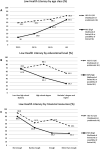Measuring health literacy combining performance-based and self-assessed measures: the roles of age, educational level and financial resources in predicting health literacy skills. A cross-sectional study conducted in Florence (Italy)
- PMID: 33020080
- PMCID: PMC7537461
- DOI: 10.1136/bmjopen-2019-035987
Measuring health literacy combining performance-based and self-assessed measures: the roles of age, educational level and financial resources in predicting health literacy skills. A cross-sectional study conducted in Florence (Italy)
Abstract
Objective: The objective was to compare the results of performance-based and self-assessed measures of health literacy (HL) and to evaluate the contribution of their joint use in assessing some HL antecedents.
Design: This was a cross-sectional study.
Setting: The study was conducted on the general population in Florence (Italy).
Participants: This study is part of a larger one, where participants were randomly selected from the registries of 11 general practitioners working in the municipality of Florence. Inclusion criteria were the following: 18-69 years of age and Italian speaking. Exclusion criteria included cognitive impairment, severe psychiatric disease or end-stage disease. In this paper, 212 adults were included.
Outcome measures: HL was measured using the European Health Literacy Survey Questionnaire (HLS-EU-Q16) and the Newest Vital Sign (NVS). The HL levels obtained by means of the two measurement tools were combined into a new variable that described three different levels of HL skills: low HL skills, partial HL skills and high HL skills. Multivariate ordinal logistic regression analysis was performed to assess the predictive roles of age class, educational level and financial resources with respect to HL skills.
Results: Twenty-two per cent of the sample had high HL skills, 28.3% had low HL skills and 49.5% had partial HL skills. Educational level, age class and financial resources were significantly associated with HL skills, with OR values being higher than those obtained using the NVS or the HLS-EU-Q16 individually.
Conclusion: The combination of the results obtained using the NVS and the HLS-EU-Q16 improves the understanding of HL. The new variable generated by this combination could be considered as a different way to assess HL and its multidimensional contents.
Keywords: preventive medicine; public health; statistics & research methods.
© Author(s) (or their employer(s)) 2020. Re-use permitted under CC BY-NC. No commercial re-use. See rights and permissions. Published by BMJ.
Conflict of interest statement
Competing interests: None declared.
Figures


References
-
- Freebody P, Luke A. ‘Literacies’ programs: debates and demands in cultural context. Prospect:an Australian journal of TESOL 1990;5:7–16.
-
- Kickbusch I, Pelikan LM, Apfel F, et al. . Health literacy. The solid facts. Copenhagen: World Health Organisation Regional Office for Europe, 2013.
MeSH terms
LinkOut - more resources
Full Text Sources
Medical
